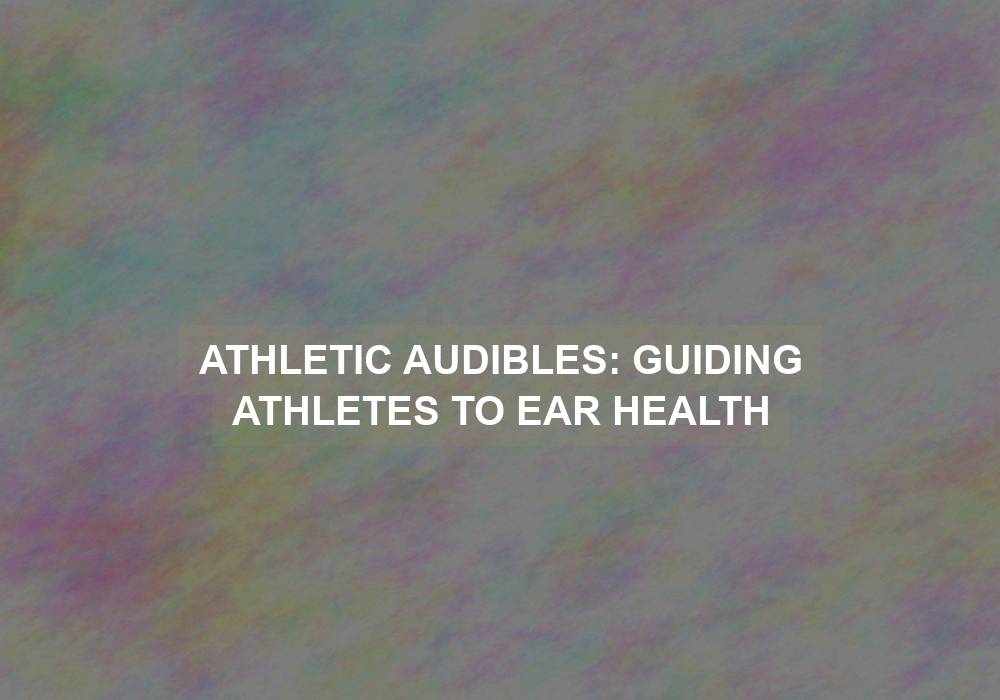In the world of sports, athletes undergo rigorous training and high-intensity workouts to optimize their performance. While much focus is placed on physical fitness and mental well-being, one aspect that often goes unnoticed is ear health. It is crucial to recognize the significance of maintaining healthy ears as it directly impacts an athlete’s ability to succeed on the field or court. This article aims to explore the importance of ear health for athletes and provide valuable insights on how to maintain optimal auditory well-being.
The Impact of Ear Health on Athletic Performance
-
Balance and Coordination: A well-functioning auditory system plays a crucial role in maintaining balance and coordination, which are essential for athletes. The inner ear contains tiny hair cells that detect motion and provide feedback to the brain. Any disruption in these delicate structures can lead to dizziness, vertigo, and decreased athletic performance. It is imperative for athletes to prioritize ear health to ensure optimal balance and coordination during physical activities.
-
Communication and Focus: Effective communication is vital in team sports, and athletes heavily rely on their hearing capabilities to understand instructions from coaches and teammates. Good ear health ensures clear auditory signals, minimizing miscommunication and allowing athletes to stay focused on the game. By maintaining healthy ears, athletes can enhance their communication skills and overall performance on the field.
-
Spatial Awareness: Sports such as basketball, soccer, or tennis require athletes to be aware of their surroundings to make split-second decisions. The ability to accurately locate the source of sounds helps athletes anticipate the actions of opponents and react swiftly. Maintaining healthy ears ensures optimal spatial awareness, giving athletes an edge on the field. By prioritizing ear health, athletes can enhance their spatial awareness and make more informed decisions during gameplay.
Common Ear Health Issues Faced by Athletes
-
Earwax Buildup: Excessive earwax can accumulate in the ear canal, causing discomfort, reduced hearing, and an increased risk of ear infections. Athletes who engage in water sports or outdoor activities are particularly prone to earwax buildup due to increased exposure to moisture and debris. It is essential for athletes to regularly clean their ears to prevent earwax buildup. However, it is crucial to use gentle methods and avoid inserting objects such as cotton swabs into the ear canal, as this can push the wax deeper or even damage the eardrum. Instead, athletes can use over-the-counter ear drops or seek professional assistance from an audiologist for safe and effective cleaning.
-
Swimmer’s Ear: Also known as otitis externa, swimmer’s ear is a common condition among athletes who spend a lot of time in water. It occurs when water gets trapped in the ear canal, creating a moist environment ideal for bacterial growth. Swimmer’s ear can cause pain, itching, inflammation, and temporarily impact an athlete’s performance. To prevent swimmer’s ear, athletes participating in water sports or activities should take precautions to protect their ears from excessive moisture. Wearing earplugs or custom-fitted swim molds can help prevent water from entering the ear canal, reducing the risk of swimmer’s ear and other related infections.
Tips for Maintaining Ear Health
-
Regular Cleaning: Athletes should clean their ears regularly to prevent earwax buildup. However, it is crucial to use gentle methods and avoid inserting objects such as cotton swabs into the ear canal, as this can push the wax deeper or even damage the eardrum. Instead, athletes can use over-the-counter ear drops or seek professional assistance from an audiologist for safe and effective cleaning. Regular cleaning helps maintain optimal ear health and reduces the risk of discomfort and hearing impairment.
-
Protection from Water: Athletes participating in water sports or activities should take precautions to protect their ears from excessive moisture. Wearing earplugs or custom-fitted swim molds can help prevent water from entering the ear canal, reducing the risk of swimmer’s ear and other related infections. It is crucial for athletes to prioritize ear protection to ensure their auditory well-being and overall performance.
-
Noise Protection: Exposure to loud environments, such as stadiums or concerts, can damage the delicate structures of the inner ear over time. Athletes should consider wearing earplugs or noise-canceling headphones during such events to protect their hearing and prevent long-term damage. By taking proactive measures to protect their ears from excessive noise, athletes can safeguard their auditory health and maintain optimal performance throughout their athletic journey.
Seeking Professional Help
It is essential for athletes to prioritize their ear health and seek professional assistance when needed. Audiologists and ear specialists can provide expert guidance and personalized solutions to address specific ear-related issues. They can conduct thorough evaluations, recommend appropriate hearing protection devices, and offer comprehensive treatments if any ear health problems arise. By consulting with professionals, athletes can ensure they receive the necessary care and support to maintain optimal auditory well-being.
Conclusion
In conclusion, maintaining optimal ear health is crucial for athletes striving for peak performance. From enhancing balance and coordination to facilitating effective communication and spatial awareness, healthy ears contribute significantly to an athlete’s overall well-being. By following the tips outlined in this article and seeking professional help when necessary, athletes can take proactive measures to safeguard their auditory health and excel in their respective sports. Remember, healthy ears lead to a healthier, more successful athletic journey.
